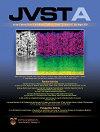采用SiCl4等离子体进行高选择性蚀刻工艺的选择性掩膜沉积
IF 2.1
3区 材料科学
Q3 MATERIALS SCIENCE, COATINGS & FILMS
引用次数: 0
摘要
我们开发了一种区域选择性沉积工艺,用于在使用微波电子-回旋-共振蚀刻系统生成的掩模顶部形成保护层。沉积层仅在SiO2掩模上形成,而不会在蚀刻区域(如图案底部和隔离蚀刻区域)的Si表面形成不必要的沉积层。利用SiCl4/H2/Cl2等离子体在SiO2掩膜上选择性地形成保护层,而不形成Si蚀刻区。在沉积前对Si和SiO2表面进行预处理对实现选择性沉积很重要,因为在清洗后的Si表面上出现了成核延迟。在硅表面,吸附的SiClx很容易通过与等离子体产生的Cl反应再次解吸。然而,由于Si-O比Si-Si具有更大的结合能,吸附在SiO2上的SiClx更难与Cl反应解吸。在SiO2掩模上选择性地形成沉积层后,利用O2等离子体处理将沉积层氧化,以提高后续Si蚀刻时的抗蚀刻性能。我们还研究了一种硅蚀刻工艺,在用SiO2掩膜蚀刻25 nm间距的线与空间硅图案时使用选择性沉积。使用选择性沉积实现了高度选择性的蚀刻,而不会在孤立的Si区域上形成不必要的沉积。本文章由计算机程序翻译,如有差异,请以英文原文为准。
Selective mask deposition using SiCl4 plasma for highly selective etching process
We developed an area-selective deposition process for forming protective layers on top of masks generated using a microwave electron-cyclotron-resonance etching system. A deposition layer is formed only on SiO2 masks without forming an unnecessary deposition layer on the Si surfaces in the etching area, such as the bottoms of the patterns and isolated etching area. The protection layers were selectively formed on a SiO2 mask without forming on a Si etching area by using a SiCl4/H2/Cl2 plasma. The pretreatment to clean the Si and SiO2 surfaces before deposition was important for achieving selective deposition because selectivity appeared by nucleation delay on the cleaned Si surface. On the Si surface, adsorbed SiClx easily desorbed again by reacting with the Cl generated from the plasma. However, adsorbed SiClx on SiO2 was more difficult to desorb by reacting with Cl due to Si–O having a larger binding energy than Si–Si. After the deposition layer was selectively formed on the SiO2 mask, the layer was oxidized by using O2 plasma treatment to improve the etching resistance during the subsequent Si etching. We also investigated a Si etching process using selective deposition during the etching of a 25 nm-pitch line-and-space Si pattern with a SiO2 mask. Extremely highly selective etching was achieved using selective deposition without forming an unnecessary deposition on an isolated Si area.
求助全文
通过发布文献求助,成功后即可免费获取论文全文。
去求助
来源期刊

Journal of Vacuum Science & Technology A
工程技术-材料科学:膜
CiteScore
5.10
自引率
10.30%
发文量
247
审稿时长
2.1 months
期刊介绍:
Journal of Vacuum Science & Technology A publishes reports of original research, letters, and review articles that focus on fundamental scientific understanding of interfaces, surfaces, plasmas and thin films and on using this understanding to advance the state-of-the-art in various technological applications.
 求助内容:
求助内容: 应助结果提醒方式:
应助结果提醒方式:


